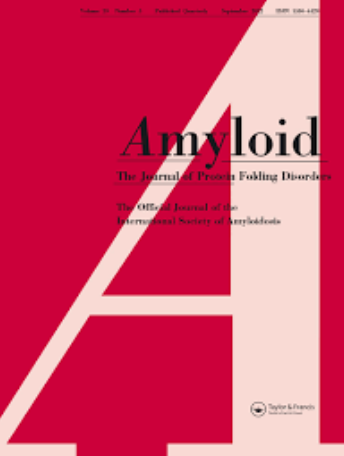A second case of liraglutide-type localised amyloidosis.
IF 5.2
2区 医学
Q1 BIOCHEMISTRY & MOLECULAR BIOLOGY
Amyloid-Journal of Protein Folding Disorders
Pub Date : 2023-06-01
DOI:10.1080/13506129.2022.2151889
引用次数: 1
Abstract
Amyloidosis is characterised by extracellular deposition of proteinaceous fibrils, disrupting tissue structure and function. There are at least 36 different types of amyloid, and correct identification of the specific amyloid precursor protein is of paramount importance, as therapy varies dramatically depending on the amyloid type. The most common amyloid types encountered in peripheral nerves are AL (immunoglobulin light chain) and ATTR (transthyretin) [1]. Iatrogenic amyloidosis is a form of localised amyloidosis, caused by the repetitive injection of protein medications, such as insulin [2]. A 78-year-old male, with a history of well-controlled diabetes mellitus, presented with a 30-year history of bilateral foot soreness and numbness. Six months prior to the presentation, he developed intermittent burning and a hot/cold sensation in his feet which spontaneously improved. He also reported a 15-year history of nonradiating low back pain. He had no weakness, weight loss, orthostatic light-headedness, or bowel or bladder dysfunction. Other family members have reported similar sensory symptoms. Neurological examination was remarkable for decreased pinprick sensation from the mid-shin down to the toes, and mildly decreased hot temperature sensation in the right foot. Reflexes were decreased at the right patella, absent at the left patella and bilateral ankles. Motor and gait examination were normal. Nerve conduction studies/electromyography demonstrated mild bilateral old or chronic L5 radiculopathies with no evidence of ongoing denervation, and no evidence of a large fibre peripheral neuropathy. Thermoregulatory sweat test showed no evidence of a small fibre neuropathy either. However, serologic evaluation, performed to screen for potential peripheral neuropathy causes prior to our evaluation, showed a triclonal gammopathy of uncertain significance (IgG j, IgG k and IgA j). Congo red stain performed on an abdominal fat aspirate was positive for amyloid (Figure 1), raising the possibility of systemic amyloidosis. The patient had TTR sequencing which revealed no mutation. Upon questioning about insulin injections, known to cause focal amyloid deposits, the patient acknowledged using liraglutide 0.6mg subcutaneously once daily. Typing of the amyloid deposit by mass spectrometry-based proteomics (liquid chromatography with tandem mass spectrometry; LC-MS-MS) using previously published methods confirmed the presence of liraglutide-type amyloid deposit (Figure 1) [3]. Immunohistochemical studies were not performed because the specimen was a fat aspirate and hence, paraffin-embedded samples were not available. Liraglutide is an acylated glucagon-like peptide-1 analogue that is administered as a subcutaneous injection for the treatment of type 2 diabetes mellitus. To date, a single case of liraglutide-type amyloidosis has been reported [4]. Liraglutide should be considered as a potential amyloidogenic agent. Our case highlights the importance of利拉鲁肽型局限性淀粉样变性2例。
本文章由计算机程序翻译,如有差异,请以英文原文为准。
求助全文
约1分钟内获得全文
求助全文
来源期刊

Amyloid-Journal of Protein Folding Disorders
生物-生化与分子生物学
CiteScore
10.60
自引率
10.90%
发文量
48
审稿时长
6-12 weeks
期刊介绍:
Amyloid: the Journal of Protein Folding Disorders is dedicated to the study of all aspects of the protein groups and associated disorders that are classified as the amyloidoses as well as other disorders associated with abnormal protein folding. The journals major focus points are:
etiology,
pathogenesis,
histopathology,
chemical structure,
nature of fibrillogenesis;
whilst also publishing papers on the basic and chemical genetic aspects of many of these disorders.
Amyloid is recognised as one of the leading publications on amyloid protein classifications and the associated disorders, as well as clinical studies on all aspects of amyloid related neurodegenerative diseases and major clinical studies on inherited amyloidosis, especially those related to transthyretin. The Journal also publishes book reviews, meeting reports, editorials, thesis abstracts, review articles and symposia in the various areas listed above.
 求助内容:
求助内容: 应助结果提醒方式:
应助结果提醒方式:


